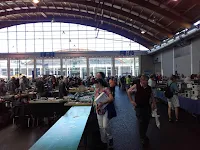 I couldn't miss a second visit to the largest ham fair in Europe, so
there I went last Friday. My main interest was the flea market, and
that's where I spent almost 8 hours. My feeling is that there were
fewer people and less sellers than 2015 edition, but last year I spent
two days and I might remember the Saturday crowd instead.
I couldn't miss a second visit to the largest ham fair in Europe, so
there I went last Friday. My main interest was the flea market, and
that's where I spent almost 8 hours. My feeling is that there were
fewer people and less sellers than 2015 edition, but last year I spent
two days and I might remember the Saturday crowd instead.
I was looking mainly for old display technologies, and it wasn't that bad.
I bought:
- IV-27M VFD (5 EUR)
- IV-22 VFD (2 EUR each)
- a board with 4xZM1000 and 1xZM1001 from Philips PM2421 (10 EUR) ... this is as old as I am!
- B5092 and alike sockets (50c each)
- two nice shaped valves (1 EUR each)
What I haven't bought:
- red-coated top-view DDR Nixies (used starting at 3 EUR, new up to 10 EUR)
- the case around the Philips board
- another Philips board with case (26 EUR)
- a 20 GHz frequency counter with Nixies, working (280 EUR)
- a DVM with 4-digit Nixie display (70 EUR, fair)
- another frequency couner with Nixies the person at the table couldn't find out the price
- a desk microphone from 50's, nice design (5 EUR)
- a desk clock-radio with a flip clock (obviously missing one palette)
What I haven't found:
- early days spare LED displays (late 70's)
Now it is time to test my purchases. IV-27M will go first, then find
out about the nice shaped valves and power up the board with ZM tubes.
 |
| View from a corner of A1, new stuff. |
 |
| Almost a panoramic view of A4, |
 |
| from the rear end of the hall. |



